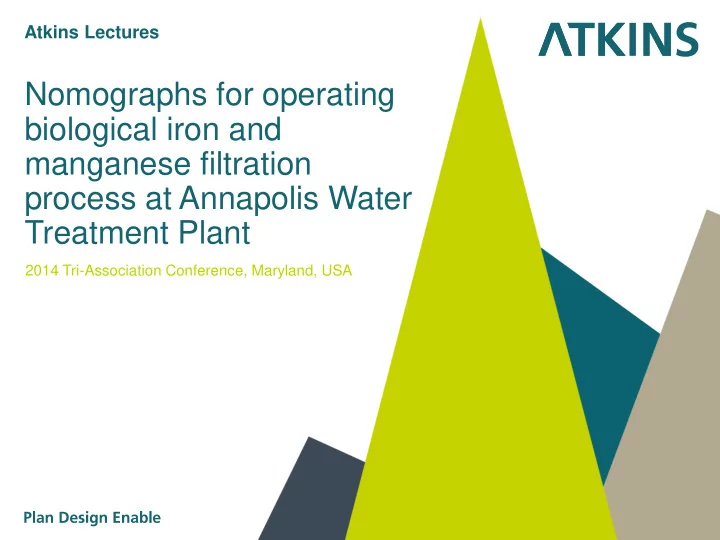

Atkins Lectures Nomographs for operating biological iron and manganese filtration process at Annapolis Water Treatment Plant 2014 Tri-Association Conference, Maryland, USA
Leita Bennett, senior project manager, North America 28 August 2014
City of Annapolis Water Treatment Plant (WTP) in Maryland, USA ● Original construction was in 1931, new plant currently being built ● Existing conventional treatment involves – Chemical pretreatment – alum and lime – Coagulation – Sedimentation – Filtration – Disinfection. 2
Raw water quality ● There are eight wells in three aquifers ● There are varying flow rates and quality ● The raw water quality is generally good – Iron (Fe) - above the USEPA SMCL of 0.3 mg/L – Manganese (Mn) – 2 to 10 times USEPA SMCL of 0.05 mg/L – Low alkalinity and low pH (potential treatability issues). 3
Annapolis WTP historical information 5/35
Design/build process of the new WTP ● City of Annapolis is the owner of the plant ● Heery /Atkins/HDR is the owner’s representative ● CDM Smith/Haskell joint venture are designing and building the new water treatment plant ● Process will include – Proposed biological filtration alternative – A pilot scale investigation – Blueleaf Inc. conducted the pilot tests.
Biological iron and manganese removal ● Ferazur and Mangazur biological filtration system by Infilco Degremont is an alternative to the existing water treatment at the plant ● 120 plants worldwide use the system (24 in US and Canada) ● There is potential for lower chemical costs ● There would be a smaller footprint ● Very sensitive to optimal pH and oxidation-reduction potential (ORP). 7
Pilot testing protocols/goals for biological iron and manganese removal ● Three individual wells (one from each aquifer) ● Five raw water blends - long term composite testing ● Finished water testing criteria (city’s pass/fail limits) – Fe – 0.15 mg/L, 95% (average 0.02 mg/L) – Mn – 0.025 mg/L, 95% (average 0.01 mg/L) ● Nomograph development ● Cost comparison with physical/chemical treatment. 8
Pilot plant overview Air 9
Critical electrochemical parameters for the pilot ● pH – acid solution – tendency low – alkaline solution – tendency high ● ORP - (pE) (tendency for oxidation) ● Dissolved oxygen (DO) ● Temperature ● Pressures through the filters ● Turbidity ● Flow. 10
Process performance (use of nomographs) ● Need conditions of pH and E h that favor bacterial activity ● Need conditions that can lead to total precipitation of Fe and Mn ● Stability zone of values for pH – E h ● What is the confidence level that we are at optimal band? ● What is the optimal operating envelope? 11
Empirical biological oxidation conditions of iron (IDI) ● Iron uptake occurs under conditions where physical/chemical oxidation is not possible ● DO = 0.2 to 0.5 mg/L ● pH = 6.3 ● E H - Redox potential = 100 mV ● rH - > 14 but less than 20 (calculated value) ● rH = (ORP +200) + (2 x pH) 30 [Clark-Nerst equation] 12
Iron and manganese removal stability diagrams ● IDI developed empirical stability diagram ● Upper and lower limits of activity zones ● Avoid areas of competition between biological and physical/chemical oxidation. 13
Process performance ● What is the operating envelope for your plant? ● How can we have more stable conditions? ● Are the operating pH and ORP values within the required range? ● What can be done to improve the conditions for successful composite testing? – pH? – ORP? – Carbonate equilibria? – Other water chemistry? 14
Defining the optimum treatability band ● Difficult when pH and alkalinity are very low – Not affected by high Fe or Mn concentrations – Very low pH and alkalinity – Low hardness ● FZ (limit averages) – pH = 5.2, ORP = 130 – pH = 5.2, ORP = 193 ● MZ (limit averages) – pH = 7.7, ORP = 304 – pH = 8.4 & ORP =224 16
Pilot study results and challenges ● 115 Ferazur runs, 20 Mangazur runs (less backwash) ● Well #10 – required multiple DO and pH changes – alkalinity adjustments ● Lime not a good option – switched to caustic (↑$) ● Instrumentation – probe cleaning, alternate control strategies, aeration relocations ● Automated aeration control needed ● Acclimation issues. 16
Pilot study results 17
Life-cycle cost evaluation Overall result – stay with existing conventional treatment at new plant. 18
Nomograph findings ● Knowledge of pH, ORP, DO and temperature data helps to define the envelope of biological activity zone ● Need to confirm the biological and physical chemical activity zones ● Biological Fe and Mn removal is best at a very narrow pH and ORP ● Nomographs can provide a valuable tool to obtain optimum operational conditions ● Boundary between physical/chemical and biological iron removal is difficult to determine. 19
For more information, contact: Leita Bennett leita.bennett@atkinsglobal.com Acknowledgements The City of Annapolis Thora Burkhardt James FitzGerald David Jarrell Lily Openshaw CDM Smith/Haskell JV Ersin Kasirga, PhD, PE Infilco Degremont Blueleaf Inc.
Recommend
More recommend